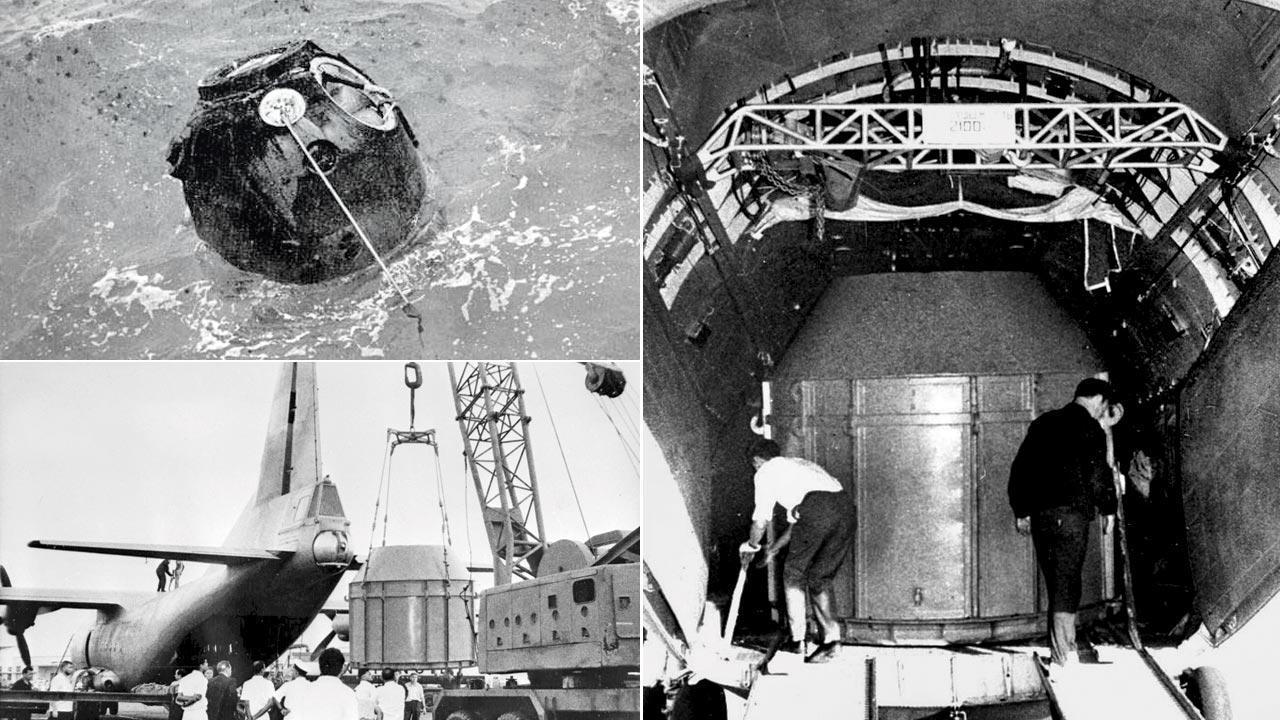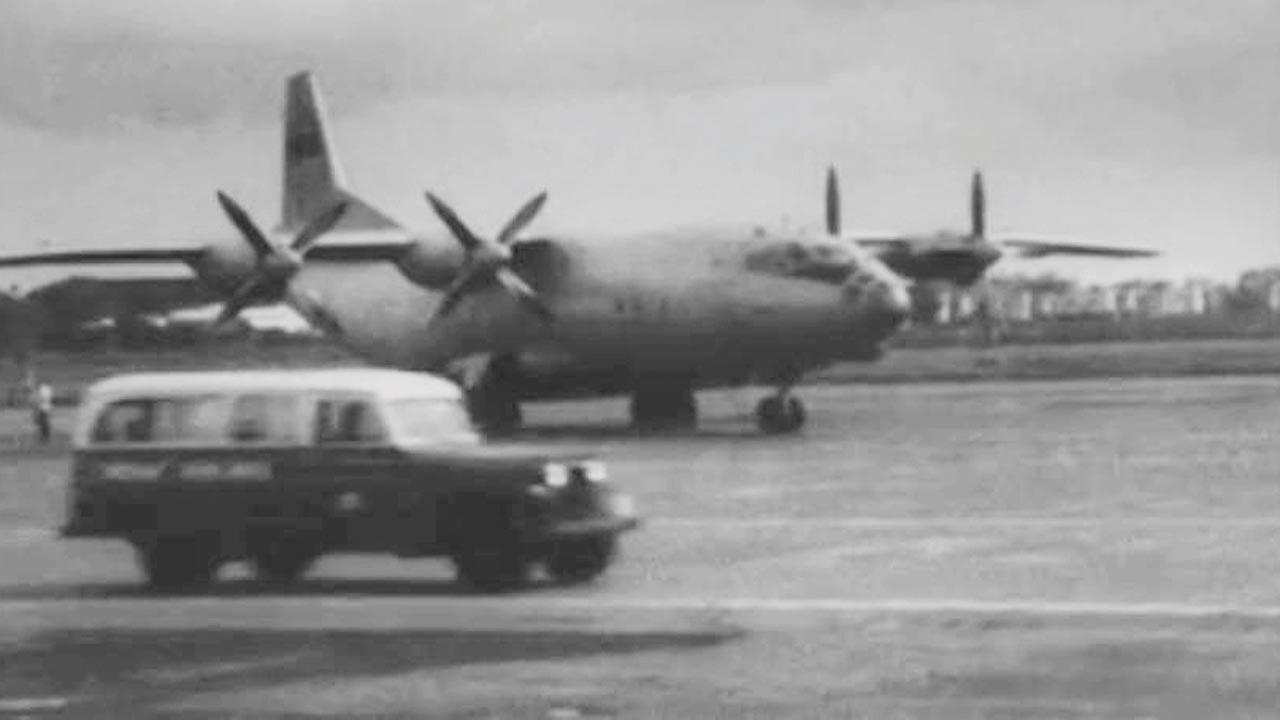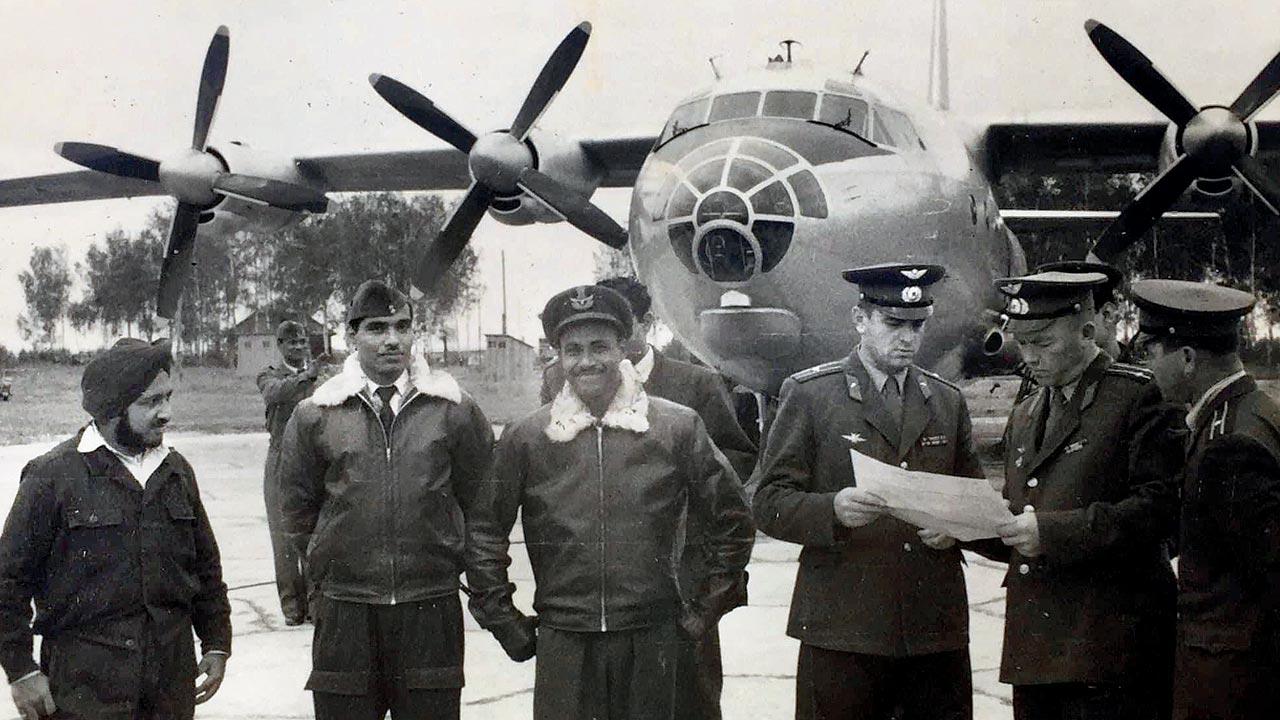While India beat Russia with Chandrayaan 3 in August, a lesser-known rescue mission of a space capsule that arrived at the Bombay Port 55 years ago, scripted the global success story of lunar programmes

The Zond 5, carrying an extensive biological payload including two steppe tortoises, took off on September 14, 1968, on a Soviet Proton UR-500K rocket, landing in the Indian Ocean a week later. Pic Courtesy/SP Korolev RSC Energia; solarsystem.nasa.gov; The Zond 5 spacecraft being loaded onto the Antonov An-12 aircraft at Santa Cruz Airport in October 1968
For years now, Santa Cruz resident Debasish Chakraverty has been trying to untangle connections his fast-gentrifying neighbourhood has had with the rest of the city. It’s why the aviation enthusiast and historian spends a lot of time scouring through archival tomes—the hope is that it will lead him to hidden stories about the gentle suburb of his childhood. During one such exercise, Chakraverty remembers coming across a passing mention of how “the first spaceship to travel to and circle the Moon” had set foot in Bombay’s erstwhile Santa Cruz airport after completing its mission. “It got me curious,” he tells us over a phone call, “because I had never heard about this incident in local legend or lore”. As he dug deeper, poring over space science articles and online records, including that of NASA, Chakraverty was able to stitch a compelling portrait of how Mumbai came to “accidentally” play a role in one of the most epic space missions—also known as Zond 5—which celebrates its 55th anniversary this week. “It has sadly been a tale lost to time, and one that we ought to remember, specifically in the light of the well-earned success of our own Chandrayaan 3 mission,” he says.
ADVERTISEMENT
Zond 5 was a Soyuz spacecraft bound for the Moon. The brainchild of the former Soviet Union, Union of Soviet Socialist Republics (USSR), which in the mid-1900s was the undisputed leader in space exploration, Zond 5 was launched on a Soviet Proton UR-500K from the Baikonur Cosmodrome in the Khazakh SSR (Soviet Socialist Republic; now the independent nation of Kazakhstan) on September 14, 1968. “What was special about it, was that it carried aboard the first terrestrial organisms to the vicinity of the Moon. They were two tortoises, fruit fly eggs, and plants,” shares Chakraverty.
 The Soviet ship, Vasily Golovnin, arriving at the Bombay Port, October 3, 1968. Pics Courtesy/Debasish Chakraverty
The Soviet ship, Vasily Golovnin, arriving at the Bombay Port, October 3, 1968. Pics Courtesy/Debasish Chakraverty
The mission, as history relays it, was a rare feat for its time. “Not only did it become the first spaceship to travel to and circle the Moon in a circumlunar trajectory, but also the first Moon mission to include animals, and the first space craft to return safely to Earth from the Moon,” he adds. But the last leg of the journey had a fair share of bumps.
Six days after it left Earth, and travelled to and back from the Moon, Zond 5 was scheduled to make a landing on the soft ground of the Kazakh steppes, on September 21, 1968. UK-based space writer Gurbir Singh, who has authored the non-fiction, The Indian Space Programme, says that the spacecraft had already “suffered star sensor failure used for attitude control en route to the Moon and another on its return journey”. “Engineers made a trajectory control manoeuvre, but the re-entry corridor was no longer the usual Mongolian desert but the Indian Ocean,” Singh shares. “This was the first USSR spacecraft to splash down… all others had landed on land.”

Debasish Chakraverty, Chaitanya Giri and Gurbir Singh
According to Chakraverty, who has been researching and reading about space explorations, the Soviet Union had two meteorological service ships in the Indian Ocean that were sent in to recover the Zond 5—the Borovichiy and the Vasily Golovnin. “While the Borovichiy was the first to reach the spacecraft, and come alongside it, as it bobbed around in the waters of the Indian Ocean, the Vasiliy Golovnin then reached the Zond 5, and hoisted it aboard.”
The question now was how to get the Zond 5 capsule back home to Moscow.
 The Antonov An-12 of the Soviet Air Force at Santa Cruz Airport, with the Zond 5 spacecraft aboard
The Antonov An-12 of the Soviet Air Force at Santa Cruz Airport, with the Zond 5 spacecraft aboard
Chaitanya Giri, associate professor (Environmental Sciences), Flame University, whose research interests traverse between analytical astrochemistry and planetary science, exploration technologies for applications in the global commons, space economy, and science diplomacy, says, “In such a situation, where space capsules, manned or unmanned, lose their desired landing trajectory or location, it becomes important to ensure there is international cooperation.” With space travel becoming more frequent in the 1960s, having such a mechanism in place was important, so that space assets were returned to the country concerned.
“The USSR,” adds Singh, “had [already] informed the Indian government in advance and the Government of India had offered to assist.”
 Squadron Leader (Later Wg. Cdr.) Dinendra Mohan Chakraverty (third from left) in the Soviet Union in 1961, where he along with other Indian pilots were trained to fly the Antonov An-12, a heavy transport aircraft
Squadron Leader (Later Wg. Cdr.) Dinendra Mohan Chakraverty (third from left) in the Soviet Union in 1961, where he along with other Indian pilots were trained to fly the Antonov An-12, a heavy transport aircraft
Soon after its rescue, the Vasily Golovnin along with the Zond 5 and its space-faring occupants set course for Bombay Port. On October 3, 1968, the ship arrived at the port. Zond 5 was offloaded from the Vasily Golovnin and loaded onto a Mercedes lorry. Later, it was transferred to a Bedford flatbed truck, which headed straight for Santa Cruz airport.
Giri says that from here, “the Zond 5 space capsule was loaded onto the Antonov An-12”. This, adds Chakraverty, was the only airplane huge enough to transport a space capsule in its massive cargo space. Incidentally, Chakraverty’s late father Squadron Leader (Later Wing Commander) Dinendra Mohan Chakraverty (Vayu Sena Medal) was part of 44 Squadron (nicknamed the “Himalayan Geese”) of the Indian Air Force, which was raised in 1961 when India bought the Antonov An-12 heavy transport aircraft from the Soviet Union. “My dad was deployed along with other Indian pilots of 44 Squadron to the Soviet Air Force Base in Sescha, Bryansk Oblast, in the Russian Soviet Socialist Republic, to learn to fly the An-12 with Soviet pilots,” he shares.
The airplane and its “precious” cargo took off the same evening. “They arrived in Moscow on October 7 [1968]. The turtles had survived the return journey to the Moon. In the ‘interest of science’ dissection on October 11 revealed that compared with a control group [which had also not been fed] the only observable effects of their space journey were those of starvation,” says Singh.
What’s interesting to note, says Chaitanya Giri, is that at the time of the incident, the Indian Space Research Organisation (ISRO), the national space agency of the country, was still a year away from being established. “This incident occurred during the tenure of the INCOSPAR [Indian National Committee for Space Research; set up in 1962].”
“This was actually a serendipitous event for us, because we had no direct role to play in this mission,” shares Giri.
Gurbir Singh says that to know the significance of Zond 5, one has to go back a few years, and understand why Moon and space missions, were attracting some of the global powers. “Although it was never overtly asserted in these terms, The Space Race in the midst of the Cold War was a proxy for dominance of political ideologies between Capitalism in the USA and Communism in the USSR,” he says, adding, “The USSR was ahead with Sputnik-1 in 1957 [the world’s first artificial satellite] and then [Yuri Alekseyevich] Gagarin in 1961 [he became the first man to journey into outer space]. This astonishing success in the USSR was seen as a failure of the USA and motivated the then new President John F Kennedy to announce in May 1961 the astonishingly bold goal of ‘landing a man on the Moon and bringing him back safely before this decade is out’. This rivalry attracted funding and perhaps more significantly political commitment in both countries.”
This, he says, also resulted in the USA and USSR courting political allegiances from countries in exchange for support to help develop their space programmes.
India’s support in the Zond 5 mission in particular, Singh believes, helped deepen the trust with the USSR. “It probably played a significant role in establishing the India-USSR 1971 Friendship Treaty where an attack on one would be an attack on both. This was identical to the mutual assistance aspect of Article 5 of the NATO [North Atlantic Treaty Organisation] Treaty—of which India nor USSR were members.” It also laid the groundwork for USSR’s support of India’s first satellite Aryabhata, says Singh. “It was built in Bangalore but launched from the USSR in 1975, and in getting India’s first cosmonaut Rakesh Sharma in space in 1984 [Sharma spent a week in the USSR space station Salyut 7].”
The US had not been far behind. “In 1975, the USA loaned its then state-of-the-art communication satellite ATS-6 [to India] to conduct the Satellite Instructional Television Experiment. For a year ATS-6 beamed educational programmes to Indian villages, without charge,” says Singh.
Collaborations continue to date. The crew of India’s Gaganyaan mission—the crewed spacecraft being developed by the ISRO—were all trained in the Yuri Gagarin Cosmonaut Training Centre or Star City in Moscow in 2020. “Several joint ISRO Roscosmos missions were planned including a joint mission to the Moon, but reliability concerns within Russia forced Russia to withdraw,” he says, adding, that events of the last few weeks also reflect how Russia’s space activities are on a decline, while India’s is on an ascendance. Russia’s space agency Roscosmos’ spacecraft Luna 25 was scheduled to soft-land near the moon’s South Pole on August 21, ahead of India’s Chandrayaan 3-moon mission. While the Luna mission turned out to be a failure, two days later, on August 23, ISRO achieved a soft landing on the South Pole of the moon, making India the first country to reach that particular area. The tides have turned, he admits. “India joined the USA’s Artemis Accords in June reflecting India’s move from Russia towards the USA. This suits India now, but geopolitical sands are always shifting,” Singh concludes.
08
No. of days the Zond 5 space capsule took to travel to and from the Moon
 Subscribe today by clicking the link and stay updated with the latest news!" Click here!
Subscribe today by clicking the link and stay updated with the latest news!" Click here!







